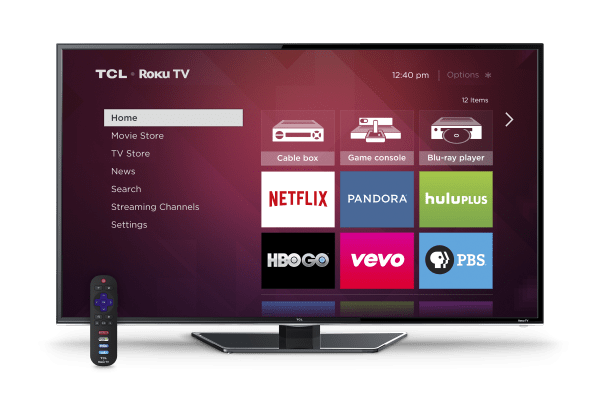For the last several years, Roku has sold a series of devices that you connect to your TV to stream a wide range of content from thousands of different apps. Roku is getting embedded directly into TVs that will go on sale in the coming months from consumer electronics manufacturers Hisense and TCL.
At the Consumer Electronics Show in January, Roku announced partnerships with Hisense and TCL, both of which committed to building Roku-powered connected TVs. Those partnerships are now bearing fruit, with both CE makers announcing their lines of Roku TV products today.
TCL will offer four Roku TV models, starting with a very competitively priced $229 32″ model. It’ll also have a 40″ Roku TV priced at $329, a 48″ model for $499, and a 55″ model for $649. Those models are available for pre-order from Amazon.com now, and will be shipped to major retailers in the coming weeks.
Hisense, meanwhile, will also soon be shipping its line of Roku-powered smart TVs. It will also have four models, starting with a 40″ model, as well as a 48″, 50″, and 55″ TVs. Those models will become available starting in late September, although pricing has not yet been announced.
In both cases, Hisense and TCL will take advantage of the large quantity of content that is available through Roku’s platform. According to Roku director of product management Lloyd Klarke, there are more than 1,700 apps available on the Roku channel store. That’s up from 1,200 at the beginning of the year, with two or three channels being added each day.
The platform has more than 200,000 movies and TV episodes available through different services like Netflix, Hulu, and others. The Roku TVs also sport a universal search functionality to find all the content users want, across various different channels.
In bringing its user interface directly to the television, Roku has attempted to streamline all the settings screens that are usually difficult to navigate. And both Hisense and TCL will offer a simplified remote control that strips away all the superfluous function buttons that come standard on many smart TV remotes.
Users will also be able to control the TVs through Roku mobile apps for iOS, Android, or Windows devices. And on a growing number of third-party apps that support the DIAL (Discovery and Lauch) protocol, users will be able to select content and then beam it to their Roku TVs, kind of like Chromecast or Airplay.
The Roku operating system also provides an easy method for accessing other devices connected to the TV. Rather than identify game consoles, Blu-Ray players, or other devices by the input they’re connected to, users can set up icons for all their favorite devices and choose from between them straight from the home screen.
For Roku, the availability of its operating system on a new group of devices could help it get wider adoption and shift it from a hardware company to a software company. The company will make money from licensing its software to be used by Hisense and TCL, and will also make money from content purchased on Roku TVs as well as advertising on those devices.
Roku has sold 8 million streaming devices in the U.S. but millions and millions of TVs are purchased each year, so there’s a huge opportunity there. With Roku-powered TVs appearing in the next month or so, it’s perfect timing for the company to cash in on sales during the holiday season.
